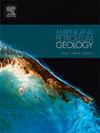洞察砂岩中自生绿泥石的形成和生长:中国西南部四川盆地沙溪庙地层的矿物学和地球化学特征分析
IF 3.7
2区 地球科学
Q1 GEOSCIENCES, MULTIDISCIPLINARY
引用次数: 0
摘要
绿泥石是一种广泛分布于砂岩储层中的粘土矿物,因其复杂的物理化学性质和独特的储层意义而备受关注。中国西南部四川盆地的沙溪庙地层具有丰富的成岩绿泥石,为绿泥石的生长理论提供了宝贵的见解。岩相观察和电子探针分析表明,自生绿泥石的形成类似于树木生长的连续、分阶段生长过程。这一过程包括从沉积矽卡岩粘土(播种)到内层绿泥石形成(发芽)、外层绿泥石发育(分枝)和孔隙填充绿泥石沉淀(开花)等阶段。在最初的埋藏过程中,沉积的闪长岩(种子)在原始地层水中铁和镁离子的影响下转变为低铁、低镁的内层绿泥石(萌芽)。在早期成岩阶段,火山碎屑和生物岩蚀变释放出大量的 Fe2+ 和 Mg2+,促进了内层绿泥石上外层绿泥石的生长(分支)。在成岩中期,火山碎屑在有机酸的影响下释放出 Ca2+、Fe2+ 和 Mg2+,导致孔隙水中的 Si4+、Al3+、Fe2+ 和 Mg2+ 过饱和,直接结晶成高八面体孔隙填充绿泥石(开花)。前驱体直闪石的存在是这一过程的基础,而充足的铁和镁源则是绿泥石形成的关键。本文章由计算机程序翻译,如有差异,请以英文原文为准。
Insights into the formation and growth of authigenic chlorite in sandstone: Analysis of mineralogical and geochemical characteristics from Shaximiao Formation, Sichuan Basin, SW China
Chlorite is a widely distributed clay mineral in sandstone reservoirs, attracting significant attention due to its complex physicochemical properties and unique reservoir significance. The Shaximiao Formation in the Sichuan Basin, SW China, features abundant diagenetic chlorite, offering valuable insights into chlorite growth theories. Petrographic observations and electron probe analyses reveal that the formation of authigenic chlorite resembles a continuous, staged growth process, akin to tree growth. This process encompasses stages from depositional smectite clay (seeding) to inner-layer chlorite formation (germination), outer-layer chlorite development (branching), and pore-filling chlorite precipitation (blooming). During the initial burial, depositional smectite (seeds) transforms into low-Fe, low-Mg inner-layer chlorite (germination) under the influence of Fe and Mg ions in the original formation water. In the early diagenetic stage, volcanic detritus and biotite alteration release substantial Fe2+ and Mg2+, fostering the growth of outer-layer chlorite (branching) on the inner-layer chlorite. In the middle diagenetic stage, volcanic detritus releases Ca2+, Fe2+, and Mg2+ under the influence of organic acids, leading to supersaturation of Si4+, Al3+, Fe2+, and Mg2+ in pore water, which directly crystallizes into highly euhedral pore-filling chlorite (blooming). The presence of precursor smectite is fundamental to this process, while sufficient Fe and Mg sources are crucial for chlorite formation.
求助全文
通过发布文献求助,成功后即可免费获取论文全文。
去求助
来源期刊

Marine and Petroleum Geology
地学-地球科学综合
CiteScore
8.80
自引率
14.30%
发文量
475
审稿时长
63 days
期刊介绍:
Marine and Petroleum Geology is the pre-eminent international forum for the exchange of multidisciplinary concepts, interpretations and techniques for all concerned with marine and petroleum geology in industry, government and academia. Rapid bimonthly publication allows early communications of papers or short communications to the geoscience community.
Marine and Petroleum Geology is essential reading for geologists, geophysicists and explorationists in industry, government and academia working in the following areas: marine geology; basin analysis and evaluation; organic geochemistry; reserve/resource estimation; seismic stratigraphy; thermal models of basic evolution; sedimentary geology; continental margins; geophysical interpretation; structural geology/tectonics; formation evaluation techniques; well logging.
 求助内容:
求助内容: 应助结果提醒方式:
应助结果提醒方式:


